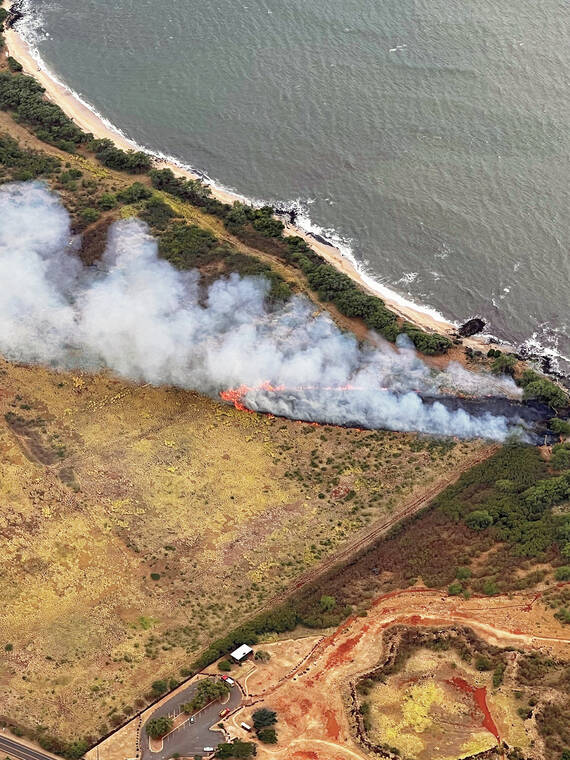LIHU‘E — As the deadliest wildfires in Hawai‘i’s recorded history ravage Maui and Hawai‘i Island, the Hawai‘i Wildfire Management Organization (HWMO) is urging Kaua‘i residents to prepare now to protect the Garden Island from the threat of inferno.
While Maui and Hawai‘i Island have historically been more prone to large fires, HWMO co-executive director Elizabeth Pickett noted that no Hawaiian island is fireproof.
“Right now is somewhat unprecedented in that there haven’t been a ton of times where we’ve had loss of life and structures,” Pickett said. “But that can happen anywhere in Hawai‘i. We always say, when the conditions are right, anywhere can burn.”
While there’s precedence for wildfires across the state, the increased risk is a more recent phenomenon. Pickett explained that more inactive agricultural fields, coupled with the spread of invasive plants, have created an increasingly flammable landscape.
“Our natural ecology is not fire prone,” she said. “But these invasive species have actually really upped our fire risk, and they’ve invaded all over — 26 percent of our state is now covered in these fire-prone invasive grasses.”
And with climate change exacerbating the impact and frequency of extreme weather events like drought and hurricane-force winds, Hawai‘i sits at the epicenter of a perfect storm for wildfires.
As the state’s grown more susceptible to fire outbreaks, Pickett told The Garden Island she doesn’t believe the state’s politicians or residents have sufficiently adapted to the state’s new reality.
“Our behaviors, our policies, our infrastructure, the way we manage our homes and yards and our larger landscapes — we just haven’t caught up to our very real and predictable fire risk. … This is our everyday reality in Hawai‘i, and I think there’s a lot we need to do to adjust everybody’s perspectives of this place that we live, in that it is one of the most fire-prone states,” she said.
To protect yourself and your home, Pickett recommended clearing the yard of anything particularly flammable.
“You want your yard to be lean, clean and green,” Pickett said. “You want to clear it of dead and dying vegetation, leaf piles and leaf debris — basically, good housekeeping. You want it to be nice and clean, so that as embers are thrown from nearby fires, when they land, there’s nothing there that’s going to smother and turn into a fire.”
Pickett also recommended regularly trimming trees and cleaning out spaces like rain gutters to reduce the risk of a fire spreading onto your property.
In addition to proactively preparing your home and yard, Pickett suggested packing an emergency go-back ahead of time containing essentials like clothes and prescription medication, as well as creating a communication plan between family and roommates, as well as elderly and mobility-challenged neighbors.
“You want to know what’s going to happen if your kids are at school or if your partner is at work,” she said. “You want to think through and talk about all those things ahead of time.”
Pickett also stressed not to wait if a wildfire is moving toward your home.
“Winds can be erratic and change direction fast — get out of there,” she said. “Don’t stay to the last minute, don’t stay until it’s mandatory. The sooner you get out, the less you’re likely to be in traffic. A lot of fatalities and other things happen when people evacuate late, or when they’re just stuck in evacuation traffic … you can always go back home if it’s a nothing burger.”
Finally, Pickett advised visitors and residents alike to maintain good fire safety practices to avoid starting wildfires in the first place.
“Please don’t drive on dry grass,” she said. “Please put your campfires out cold — all the way cold. Not just buried, not still hot, not embers — cold. And really be aware of the conditions around you if you’re going to use any equipment that sparks. If it’s windy, if it’s hot and dry, if there’s nearby dry vegetation, that’s not the time or place to do any welding or grinding outside.”
“Fire and flames can only travel where there is fuel, so we can manage our vegetation,” she continued. “We can create defensible space around our homes. We can harden our homes with noncombustible building materials, and we can prepare our families for the fact that if a fire comes, we need to evacuate, and evacuate early. There’s so much we can do to minimize fire’s ability to travel across the landscape and do harm, and there’s so much we can do to make it not a traumatic event if it does come our way.”
HWMO and Kaua‘i County urge residents to sign up for the county’s free alert system, which provides real-time updates via voice, SMS and email during severe weather and emergencies. Sign-ups can be made at entry.inspironlogistics.com/kauai_hi/wens.cfm.
Additionally, Pickett recommends Kaua‘i community members sign up for Firewise USA, a network of residential groups dedicated to protecting families and communities from wildfire threats. Residents can learn about how to organize a Firewise USA site at www.nfpa.org/Public-Education/Fire-causes-and-risks/Wildfire/Firewise-USA/Become-a-Firewise-USA-site.
•••
Jackson Healy, reporter, can be reached at 808-647-4966 or jhealy@thegardenisland.com


